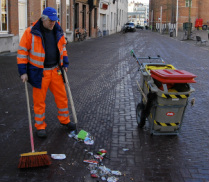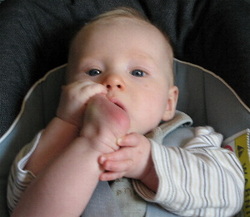10 steps to a perfect radio interview
1. Key messages
Rather than worrying about every possible question, think about the main topics that are likely to come up.
You can then develop some 'key messages' that you might want to get across. Start by making a pretty broad list, perhaps a page full of key points about the subject. Then, try to summarise them into three key messages.
Throughout the process, ask yourself: "What do you want the listener to take away from the interview?". If you’re not sure what you want to get from the interview, look at the Why Bother? section.
You can then develop some 'key messages' that you might want to get across. Start by making a pretty broad list, perhaps a page full of key points about the subject. Then, try to summarise them into three key messages.
Throughout the process, ask yourself: "What do you want the listener to take away from the interview?". If you’re not sure what you want to get from the interview, look at the Why Bother? section.
2. Pre-empt obvious questions
An endless list of pre-prepared answers is not the solution as the interviewer is unlikely to ask exactly what you expect.
However, it's worth thinking through a handful of obvious questions and how you would work in your key messages. For example, many interviews start with a variation on the question - "What's going on?"
Never give the impression that you think the interviewer is daft for asking a silly question. Instead, see these questions as an 'open goal' - allowing you to get your point of view across.
However, it's worth thinking through a handful of obvious questions and how you would work in your key messages. For example, many interviews start with a variation on the question - "What's going on?"
Never give the impression that you think the interviewer is daft for asking a silly question. Instead, see these questions as an 'open goal' - allowing you to get your point of view across.
3. Relax – they probably don’t want you to look stupid

Pulling your hair out is unlikely to help
Telling someone who is stressed that they need to relax is likely to leave you with a black eye.
However, it’s worth bearing in mind that unless your story is controversial or you are a local politician, then they probably don’t want you to look silly.
You’re unlikely to get a list of questions in advance but you can usually ask for a general idea of what kind of things you might be asked about.
Producers like to have a range of voices as guests on the air, so try not to feel self conscious.
However, it’s worth bearing in mind that unless your story is controversial or you are a local politician, then they probably don’t want you to look silly.
You’re unlikely to get a list of questions in advance but you can usually ask for a general idea of what kind of things you might be asked about.
Producers like to have a range of voices as guests on the air, so try not to feel self conscious.
4. Tone
Be enthusiastic, personal and positive (except for the exceptions where you might need to replace enthusiasm with empathy).
Try to think of it as a chat to a large group rather than a lecture.
Intonation in your voice is good as it will help listeners remember what you said.
Try to think of it as a chat to a large group rather than a lecture.
Intonation in your voice is good as it will help listeners remember what you said.
5. Avoid jargon and acronyms

A 'binman' or a 'waste removal engineer'?
If you want to reach people who aren’t already familiar with your work, don’t spend your whole interview talking about your 'strategic business plan'.
However, do consider ‘name checks’. Many listeners will have missed the start of the interview, so won’t know who you are or what you are representing (e.g. “At the Lincolnshire Ladybird Association we think that...”)
However, do consider ‘name checks’. Many listeners will have missed the start of the interview, so won’t know who you are or what you are representing (e.g. “At the Lincolnshire Ladybird Association we think that...”)
6. Answer length
There are no strict rules but aim for an answer of between 10 and 30 seconds - any shorter isn't a chat (and is a missed opportunity), any longer can be a bit dull.
Consider answering by repeating part of the question to keep your answers clear and 'media friendly'. (e.g. Q. “So why should people come along?” A: “Everyone should come along this Saturday because…”).
Consider answering by repeating part of the question to keep your answers clear and 'media friendly'. (e.g. Q. “So why should people come along?” A: “Everyone should come along this Saturday because…”).
7. One question, one answer

A long list can be confusing
Generally speaking, each answer should only attempt to make one point.
There are three reasons why you shouldn’t answer in massive lists. Firstly, because it makes it difficult to edit out a soundbite. Secondly, because you’ll forget your final point. And third…erm, what was the third point?
There are three reasons why you shouldn’t answer in massive lists. Firstly, because it makes it difficult to edit out a soundbite. Secondly, because you’ll forget your final point. And third…erm, what was the third point?
8. What I can tell you is…
You will occasionally be asked a question you don’t know the answer to.
A useful technique is to steer the question around to what you do know about.
For example, if you were new to a charity and were organising a fun run, you might not actually know how much money has been raised in the last ten years through the event.
However, you could respond by saying “Well, I’m still quite new to this, but what I can tell you is that this year we’re hoping to raise well over three thousand pounds – and we need the support of everyone in Sometown to achieve that”
It keeps the conversation going and gets your message across.
On a similar note - a good interviewer will pick up on the things you say rather than sticking to a list of questions. So, consider throwing in some carefully crafted 'teases' towards the end of an answer which the journalist can then pick up on. A decent interviewer will be listening carefully enough to ask you to explain more.
A useful technique is to steer the question around to what you do know about.
For example, if you were new to a charity and were organising a fun run, you might not actually know how much money has been raised in the last ten years through the event.
However, you could respond by saying “Well, I’m still quite new to this, but what I can tell you is that this year we’re hoping to raise well over three thousand pounds – and we need the support of everyone in Sometown to achieve that”
It keeps the conversation going and gets your message across.
On a similar note - a good interviewer will pick up on the things you say rather than sticking to a list of questions. So, consider throwing in some carefully crafted 'teases' towards the end of an answer which the journalist can then pick up on. A decent interviewer will be listening carefully enough to ask you to explain more.
9. Deflect controversy

Foot in mouth disease should be avoided...
If your press release is non-controversial, you’re unlikely to face a barrage of difficult questions. However, it's worth being aware of your 'skeletons' and thinking how you would deal with them as journalists sometimes go off topic.
You might like to consider the ‘ABC’ technique.
For example, if you were asked why building an extension to your property was causing such disruption you could:
A - Acknowledge that it’s not a stupid question (“Yes, there is a lot of building work going on and unfortunately it is inconvenient for some local people…”).
B - Change the direction of the question with a ‘Bridge’ (“…but what we’d like to say to local people is that…”).
C - Communicate your key message (“….this will soon be a bigger, brighter office which will bring new jobs and new business to this town. So if you can just bear with us, it will be worth it!”)
You might like to consider the ‘ABC’ technique.
For example, if you were asked why building an extension to your property was causing such disruption you could:
A - Acknowledge that it’s not a stupid question (“Yes, there is a lot of building work going on and unfortunately it is inconvenient for some local people…”).
B - Change the direction of the question with a ‘Bridge’ (“…but what we’d like to say to local people is that…”).
C - Communicate your key message (“….this will soon be a bigger, brighter office which will bring new jobs and new business to this town. So if you can just bear with us, it will be worth it!”)
10. Role play
Give a colleague a copy of your press release and ask them to interview you as if they know nothing else about the event.
Ask them to take a note of your persona, your language and your ‘message’ (what they took from the interview).
You may find it useful to download the interview practice sheet below (right click, 'save as').
Ask them to take a note of your persona, your language and your ‘message’ (what they took from the interview).
You may find it useful to download the interview practice sheet below (right click, 'save as').
| Interview role play worksheet | |
| File Size: | 47 kb |
| File Type: | |
